#beekeeping
Text
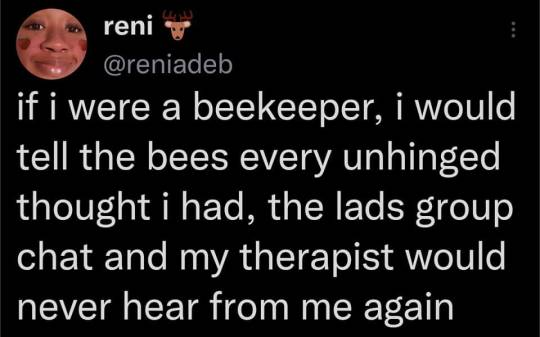
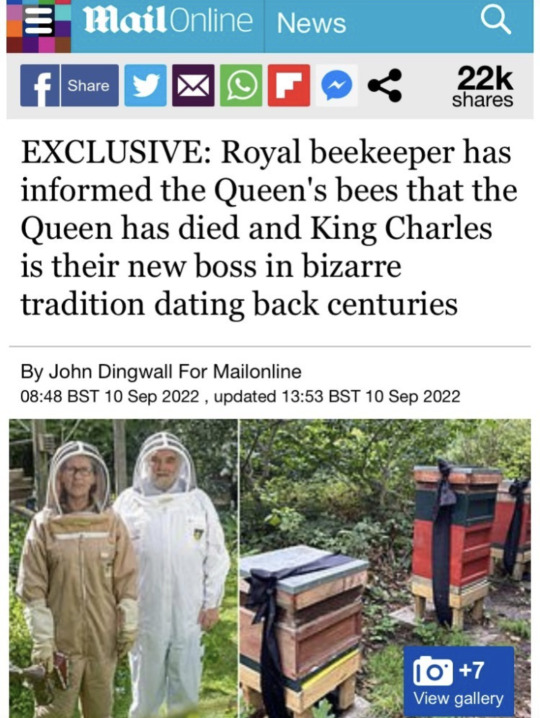
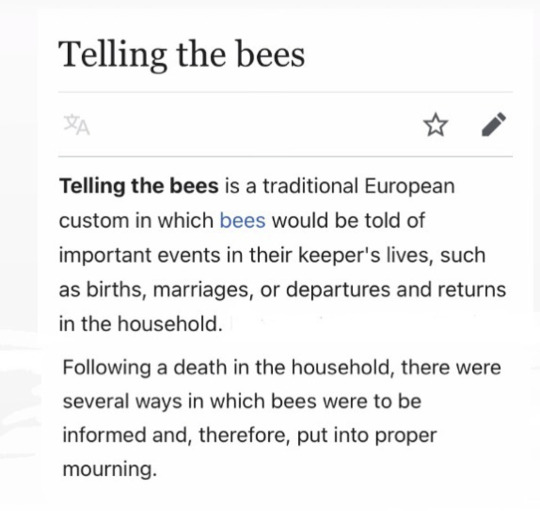
🐝🐝🍯
#queen elizabeth#uk politics#british royal family#royal family#bees#meme#funny#memes#relatable#relatable memes#relatable meme#therapy#group chat#beekeeping
19K notes
·
View notes
Text
AUTHORS DOING OTHER STUFF
Like putting together a bee hive. Badly. With the aid of Cheezits.
I’m not the only author who keeps bees by the way. I know @neil-gaiman used to keep them in Wisconsin. And Sherlock Holmes gave it a go, too, so it’s not a bad gig for a historian-turned-mystery-writer, either.
Yes. I might be procrastinating.
#authors#author problems#writerslife#writer on tumblr#cozy mystery#neil gaiman#bees#beekeeping#procrastination
789 notes
·
View notes
Text

after work hangout 🌙
#Halloween#fall#harold…#lgbtq#kbeescraft#medieval#plague doctor#beekeeping#art#artists on tumblr#character art#character concept#happy fall#happy halloween#digital painting#costume#medieval times#spooky season#goth#art history#romantic academia#dark academia#lgbtqia#illustration#queer#lesbian#valentines day#stars#valentine’s day#happy valentine's day
938 notes
·
View notes
Text
Another cool fact about the Americas and food.
It is common to say that the Americas don't have any native honeybees, but Central and South America very, very much do!
They belong to a different group, stingless bees or meliponines, and various indigenous groups have practiced beekeeping and have had honey since long before the Colombian exchange
Unfortunately they are becoming endangered because introduced bees are more profitable and we all are forced to survive under capitalism :(
845 notes
·
View notes
Text
Eugene: Wednesday, are you sure this will help me get a hot werewolf girlfriend in time for the Rave’n?
Wednesday: Of course Bee-Boy, they go wild for it for some reason. I mean, what’s not to love about it?
Eugene: I’m not sure, Enid said it looked silly.
Wednesday: All I know is that she rips it off me whenever I wear mine.
Eugene: ………..
Wednesday: Just give me your infernal phone Eugene I haven’t got all day.

Credit to @caitlynskitten who is inspiring these unhinged beekeeping thoughts.
#wenclair#enid sinclair#wednesday x enid#wednesday#wednesday addams#wednesday netflix#wednesday is soft for enid#enid is a lesbian#wlw love#wednesday beekeeping suit#beekeeping#eugene ottinger#incorrect wednesday quotes
199 notes
·
View notes
Text

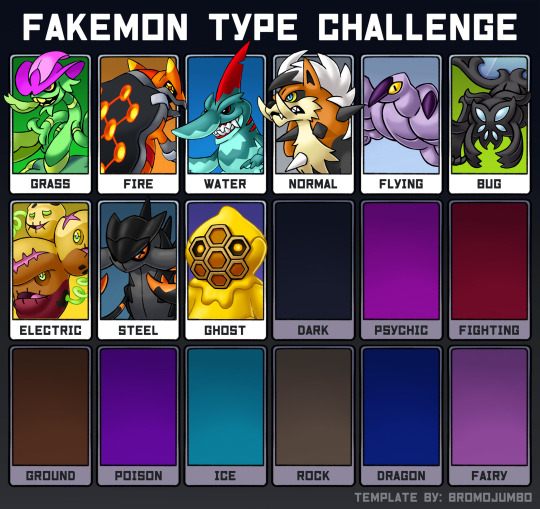
Fakemon Challenge #9 - BEEKREEPER (Ghost) The Honeyman pokemon
This pokemon is based on the "Mellified Man", also known as the "Human Mummy Confection", a supposed medicinal honey made from a human corpse that was said to cure any illness or wound, and also medieval Beekeepers
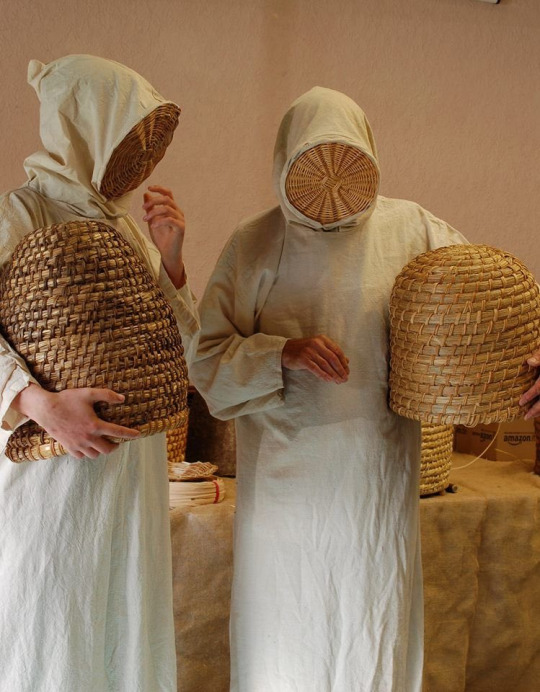
This pokemon creates honey by consuming the meat of other pokemons, this give the honey on its body weird and powerful properties, however it needs to be processed and purified before it can be used on humans. However this honey in its natural form is said to attract a very specific type of pokemon.
#pokemon#fakemon#fake pokemon#ghost#ghost type#ghost pokemon#ghost fakemon#mellified man#honey#beekeeper#beekeeping#medieval beekeeper
573 notes
·
View notes
Text
It is February my bees do NOT need to be as aggressive and active as they are being right now
#trying to do a varroa treatment and they are NOT happy#girls it is like fifty degrees out. go back to sleep#beekeeping
151 notes
·
View notes
Text

Happy Birthday to the world's greatest detective~! 🎊🎈
177 notes
·
View notes
Text
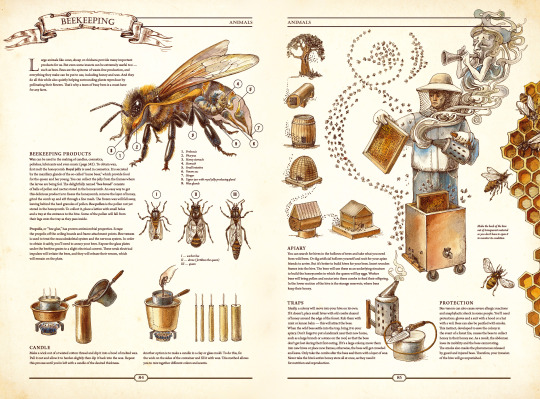
Guide To Beekeeping
---
Source: "The Book"
253 notes
·
View notes
Text
Wednesday wanted to go beekeeping with Enid:

Enid trying not to offend Wednesday's "stingy" hobby:

#doodle#enid sinclair#wednesday fanart#wenclair#digital art#wednesday#beekeeper Wednesday#Enid hates bees#wednesday is soft for enid#wednesday netflix#beekeeping#my art
113 notes
·
View notes
Text
What an asshole.






748 notes
·
View notes
Text
I see so much pro honey complete misinformation being spread on this hellsite about how bees produce too much honey so the lovely beekeepers are doing them a favour by stealing their honey and selling it and how the oh so kind beekeepers care so much for their bees (and totally not about the money they're making them...) that I fell down a rabbit hole about why honey is so bad and now I'm angry.
Also bees have been around for like 130 million years, do you not think they've got survival down??? Like they know how much food to make to survive, stop stealing their life's work to put in your tea/on your food.
280 notes
·
View notes
Text
I'm very scared of bees irl and have no room for a hive anywhere but I've been looking into getting into beekeeping. I like the idea of bees. I romanticise bees. manic pixie dream bees
58 notes
·
View notes
Text


"[T]his mouse was mummified by insects. Mice often enter honey bee hives in winter in search of a warm home. Honey bees would not tolerate such an invasion during the summer, but during the winter, they are clustered around the brood in the center of the hive and the corners of the hive interior go undefended, especially during colder weather. Sometimes the invading mice die a natural death, or perhaps the bees attack and kill them on a warm day in early spring (Should have left earlier!). In either case, the honey bees now have a dilemma because a mouse corpse is too big for them to carry out of the hive as they do with the bodies of dead bees and other debris. Their solution is to cover the cadaver with propolis, which effectively seals the dead mouse off from the rest of the hive. Notice they did remove the hair first.
Honey bees make propolis by gathering sap and other exudates from trees and mixing it with beeswax and saliva. The result is a glue-like substance that they use to seal small cracks, glue things in place, and help maintain sanitary conditions. Propolis is sticky and pliable at normal summer temperatures but becomes hard and brittle when cold. Propolis has antifungal and antibacterial properties." (source)
124 notes
·
View notes
Text
Sorry @caitlynskitten I’ve had this in my head all day and it’s so stupid but I have to let it out.
Wednesday and Enid have their only argument in their whole relationship when Wednesday wants to wear her beekeeping suit to get married in. Enid won’t allow it and that makes Wednesday upset and she lashes out at Enid verbally.
She is immediately apologetic to Enid and begs her forgiveness. Enid sees how passionate she is about wearing it and says she can wear it after the wedding until the evenings dancing.
Which is why most of their wedding photos show a tall beautiful blond wolf, wearing a long pink wedding dress with intricate lace details,, standing arm in arm with a blank faced Latina seer wearing an immaculately tailored beekeeping suit.
#wenclair#enid sinclair#wednesday x enid#wednesday#wednesday addams#wednesday netflix#wednesday is soft for enid#enid is a lesbian#wlw love#wednesday beekeeping suit#beekeeping#werewolf wednesday
65 notes
·
View notes
Text
Meadmaking
Hey all, Zoe here - the other half of this blog, and I decided to try my hand at posting - particularly my little mead-making project.
Even though Mac is the medieval drinks expert, I just like mead as a drink and I feel like a potion-brewing witch when I make it. Beer was the more popular drink during the middle ages, as it was cheaper and more widely available, but I think it's nasty and who doesn't want to feel like Early English royalty?
As I dug into mead-making, I fell into a SUPER deep medieval-mead-making rabbit hole.
I'm not a mead expert, and I'd highly recommend Susan Varberg's blog, Medieval Mead & Beer, for a very, very in-depth look at how to make medieval mead. HOWEVER, all that said, I did collect some research and played with it myself. Plus, I made some of my own recipes.
So. Mead.
What is it? Fermented honey water, in its most basic form. Honey-wine, it can be called to those who aren't familiar. There's a lot of other names mead has when it's mixed with other things:
Mead – water, honey and yeast
Sack Mead – mead made with extra honey
Short Mead – low honey and low alcohol yeast to be drunk quickly
Hydromel – watered down mead (in period, another word for mead)
Braggot – (period) ale refermented with honey; (modern) malted mead
Melomel – mead made with fruit
Mulsum – mead made with fruit
Cyser – mead made with apples
Metheglin – mead with spices
Pyment, Clar – mead made with grape juice
Hippocras – spiced wine, sweetened (but not fermented) with honey
Botchet — caramelized honey mead
Really, though, when you see it on the shelf, a pumpkin melomel will be marketed as "Pumpkin Mead," so really only the brewmasters get into the weeds on the names.
I was really curious as to how the ingredients were sourced in the middle ages - nowadays, brewers get really into where they source their ingredients (there's a bazillion different yeasts you can use!), but after doing some research, turns out the medievals were too!
Honey.
The medievals categorized honey in different ways. The best quality honey was called "life honey" and was the honey that dripped freely from the wax when pierced. Grades of honey diminished as the honey became harder to get out of the hive. The dregs of honey (collected by heating the frame in water to blend the honey but not melt the wax) was given to servants and was not preferred.
Honey was also categorized by location - Egyptian honeys were very popular and expensive. Honey from different regions in Spain were considered of different quality - one merchant got particularly fussy when one of his batches was "spoiled" by mixing honey from a better region with that from a worse region.
Finally, honey was categorized by flower type. One monetary requested honey made only from lavender. Since hives were highly mobile frames or skeps, it would have been possible for apiarists to move their hives to lavender fields.
Water.
Water is, well, water. Right? Not quite. Medieval recipes do specify using fine, spring water. The water and honey were often boiled together - likely to kill bacteria. However, the wording on "boille" is not super clear. Mead-masters knew that honey shouldn't be boiled (it kills natural yeast), so whether or not the must (the water/honey mix) was boiled in the modern sense or just warmed is unclear. Perhaps the need for "fine, spring, fresh water."
Yeast.
While modern brewers and vintners have a wide variety of yeasts to choose from, medieval brewmasters didn't have as many options. There were a few different options, however. Baking yeast (like a sourdough starter) was one option, while other recipes call for the leftover lees of wine/mead batches. Hops were also used. Of course, yeast is also naturally occurring, so brewers could fairly reliably rely on the natural yeast to kick-start itself.
I'll dump my own mead pics here and then get into the details of a Middle English mead recipe in part two, I guess. I'll talk a bit about the mead-making process, too.
Mead is made by mixing honey and water into a must. Then, yeast is added. Modern mead-makers also add yeast nutrients and other additions to ensure their batch doesn't get infected.

A newly made bottle of mead. Notice the cloudy colour characteristic of new mead. As the yeast eats the sugars, they'll create a bottom layer of debris and the mead will clear, as seen below.
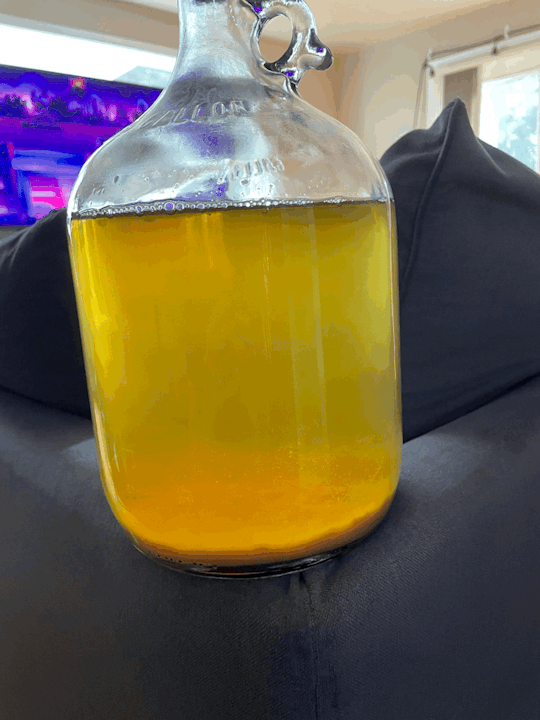
After the primary fermentation has occurred (you can tell when the bubbles of gas, telling you the yeast is eating, have stopped), mead-makers will re-reack their mead. This involves moving it from one jug to the next.

At this point, the mead can be put into a closet and age for a while. The best meads have high clarity - that is, they're clear! The example below is only about 2 months old. It has a way to go, but has good clarity already. Notably, the sagas state that the best, oldest, clearest meads were served to Odin and the gods.

Anyway - that's the basics of mead-making. I'll make a part two about older recipes!
Sources:
Beekeeping in late medieval Europe: A survey of its ecological settings and social impacts. Llu.s SALES I FAVÀ, Alexandra SAPOZNIK y Mark WHELAN
Trade, taste and ecology: honey in late medieval Europe. Alexandra Sapoznik, Lluís Sales i Favà & Mark Whelan
Of Boyling and Seething: A re-evaluation of these common cooking terms in connection with brewing. Susan Verberg.
#bees#beekeeping#mead#mead-making#mediveal#medieval literature#witches#cottagecore#potions#i feel like a witch#maniculum
122 notes
·
View notes